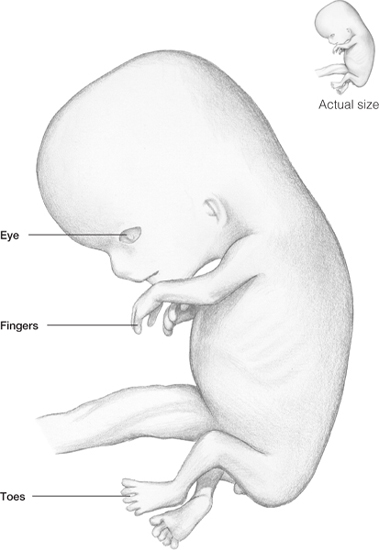2. Celiac Disease
Celiac disease, also called celiac sprue, nontropical sprue and glutensensitive enteropathy,
is a digestive disease that affects the small intestine. If you have
celiac disease, you have an allergy to gluten, which is found in wheat,
oats, rye and barley. This allergy causes your immune system to attack
your intestines so you absorb fewer nutrients. Symptoms include
diarrhea, abdominal pain, bloating, irritability and depression.
How Is Pregnancy Weight Distributed?
When a baby is born, an average-weight
mother should have gained between 25 and 35 pounds. A woman who has
gained 30 pounds may see her weight distributed as shown below.
|
11 pounds |
Fat, protein and other nutrients in mom |
|
4 pounds |
Increased fluid volume |
|
2 pounds |
Breast enlargement |
|
2 pounds |
Uterus |
|
7½ pounds |
Baby |
|
2 pounds |
Amniotic fluid |
|
1½ pounds |
Placenta |
The condition is hereditary and occurs
more often in women than men. It’s most common in Western Europeans and
rare in Africans and Asians. We believe celiac disease affects 1 in 100
people worldwide and 1 in every 133 Americans. It may be overlooked
during pregnancy because symptoms can be the same as for other problems.
Many healthcare providers don’t know much about the disease, and it can
be difficult to diagnose.
A blood test can determine if you may have a problem with celiac disease. A biopsy of the small intestine can confirm it.
If you have celiac disease, it’s important
to have it under control before pregnancy by eating a gluten-free diet.
You can learn whether a food contains gluten by reading labels because
manufacturers are required by law to list this information. Many foods
are now gluten-free. Because folic acid is found in many fortified grain
products, you will probably need supplements to ensure you receive
enough folic acid.
Tip for Week 9
It’s an old wives’ tale that your hair
won’t curl if you have a permanent during pregnancy. Our only precaution
is that if odors affect you, the fumes from a permanent or hair
coloring could make you feel ill.
Celiac disease may
appear for the first time during pregnancy or after childbirth. If you
have symptoms, talk to your healthcare provider. You may need to meet
with a dietician to develop a nutritional meal plan.
3. Changes in You
Your blood system changes a lot during pregnancy, and the amount of blood in your body, called blood volume,
increases as much as 50%. Higher blood volume helps meet the demands of
your growing baby and helps protect you both. It’s also important
during labor and delivery, when some blood is lost.
Increased blood volume begins during the
first trimester. The greatest increase occurs in the second trimester.
It continues to increase but at a slower rate during the third
trimester.
Dad Tip
Ask your partner which prenatal visits
she’d like you to attend. Some couples attend every visit together, when
possible. Ask her to let you know the date and time of each
appointment.
The increase in red blood cells
increases your body’s need for iron and can cause anemia. If you’re
anemic during pregnancy, you may get tired easily or feel ill.
4. How Your Baby Is Growing and Developing
If you could look inside your uterus, you’d see many changes in your baby.
Baby’s arms and legs are longer. Fingers
are longer, and the tips are slightly enlarged where touch pads are
developing. The feet are approaching the midline of the body and may
meet in front of the torso.
The head is more erect, and the neck is
more developed. The pupil forms this week, and the optic nerve begins to
form. Eyelids almost cover the eyes; up to this time, eyes have been
uncovered. External ears are evident and well formed. Your baby now
moves its body and limbs. This movement may be seen during an ultrasound
exam.

Embryo at 9 weeks of pregnancy (fetal age—46 to 49 days).
Toes are formed and feet are more recognizable.
Crown-to-rump length is about 1 inch (25mm).
The baby looks more
recognizable as a human being, although it is still extremely small. But
you still can’t tell the difference between a boy and a girl. You won’t
be able to do that for another few weeks.